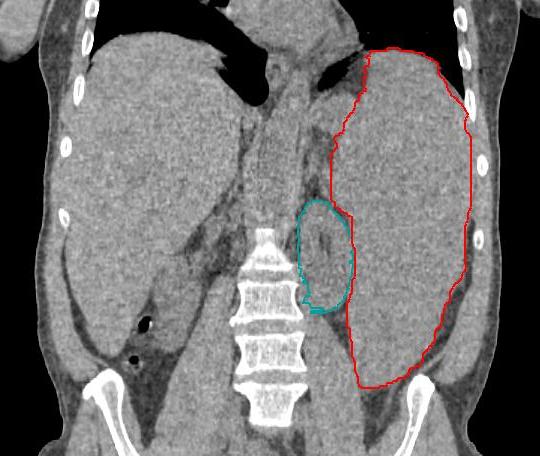Difference Between Aplastic Anemia and Myelodysplastic Syndrome

Enlarged spleen due to myelodysplastic syndrome; CT scan coronal section. Spleen in red, left kidney in green.
Aplastic Anemia vs Myelodysplastic Syndrome
Aplastic Anemia and Myelodysplastic Syndrome are conditions that affect the bone marrow and the blood cells that it produces. Bone marrow is a sponge like tissue found inside bones like breastbone, ribs, pelvis, spine and skull. It produces the original (stem) cells which undergo division to produce myeloid stem cells. Myeloid stem cells are cells that produce red blood cells, white blood cells and platelets.
In Myelodysplastic Syndrome (MDS), there is impaired production of myeloid class of blood cells by the bone marrow whereas aplastic anemia is a condition in which the bone marrow is damaged leading to decreased new blood cell production. In MDS, the bone marrow produces new blood cells but they are abnormal and deformed whereas in aplastic anemia, the bone marrow stops producing new blood cells.
MDS commonly affects men above the age group of 60 yrs whereas aplastic anemia is commonly seen in teenagers and young adults. In 1/3rd cases, MDS may progress to acute myeloid leukemia which is a rapidly growing cancer of the bone marrow.
Aplastic anemia and MDS are triggered due to exposure to chemotherapy/radiotherapy which is used in cancer, chemicals like benzene, and insecticides. In aplastic anemia, our immune system attacks the healthy cells of the bone marrow and affects the production of new blood cells. It is also caused due to infections (Hepatitis, Parvovirus B19, HIV), use of drugs like carbamazepine, chloramphenicol, etc whereas in MDS the cause is usually unknown. MDS is thought to be triggered due to exposure to heavy metals (mercury/lead) and tobacco smoke.
Symptoms appear due to pancytopenia seen in both conditions. Pancytopenia is a decrease in red blood cells, white blood cells and platelets. Decreased red blood cells causes anemia. Thus, patient develops symptoms like fatigue, weakness and breathlessness. Decreased white blood cells cause increased tendency to develop infections. Decreased platelets cause easy bruising and bleeding i.e. nose bleeding, gum bleeding,etc.
Diagnosis is confirmed by blood investigations like a complete blood count.
In MDS and aplastic anemia, it will show a decrease in haemoglobin, red blood cells, white blood cells and platelets. Bone marrow biopsy will help us to differentiate the two conditions. Here a sample of the bone marrow is removed from the hip bone and examined. Aplastic Anemia shows hypocellular bone marrow as the blood cells are replaced by fat whereas in MDS, the bone marrow is hypercellular and there are excessive abnormal cells.
Treatment will depend on the age of the patient, general health and risk factors involved. In both cases, firstly supportive treatment is provided. It includes blood transfusion and antibiotics to control the infection. In aplastic anemia, immunosuppressant drugs are used. They are drugs that suppress the activity of immune cells which damage the bone marrow. In young patients, bone marrow transplant is helpful. In MDS, single drug or combination chemotherapy is used. Immunosuppressants are also helpful. Bone marrow transplant is a choice of treatment but there are risk factors involved. In Aplastic Anemia, survival rate is 5 yrs whereas in MDS, survival rate is 6 months to 6 yrs.
Summary
Aplastic anemia and MDS are blood disorders that affect the bone marrow and blood cell production. In aplastic anemia, the bone marrow is damaged and stops producing new blood cells whereas in MDS, the bone marrow produces excessive new blood cells but the cells are abnormal and deformed. Symptoms in both conditions include anemia, tendency to infections, easy bleeding and bruising. Diagnosis is done by complete blood count and bone marrow biopsy. Treatment will include blood transfusion, immunosuppressants and bone marrow transplant in young patients.
Image Credit : http://commons.wikimedia.org/wiki/File:Tumor_Myelodysplastic_Spleen.JPG
- Difference between near sightedness and far sightedness - January 21, 2015
- Difference between Diverticulosis and Diverticulitis - January 20, 2015
- Difference between Prilosec and Nexium - January 19, 2015
